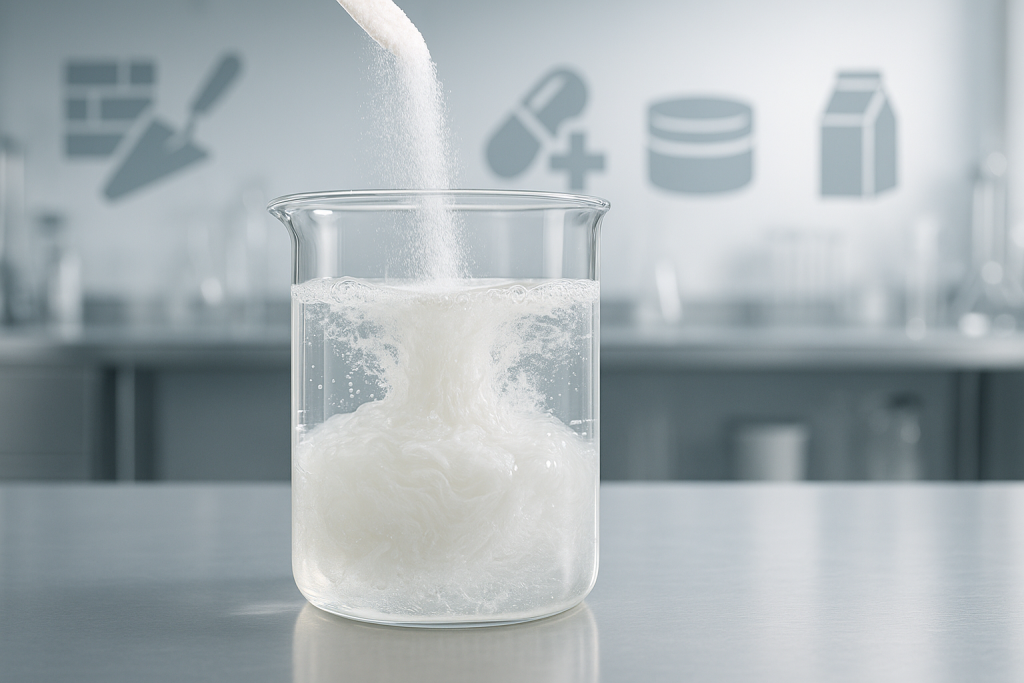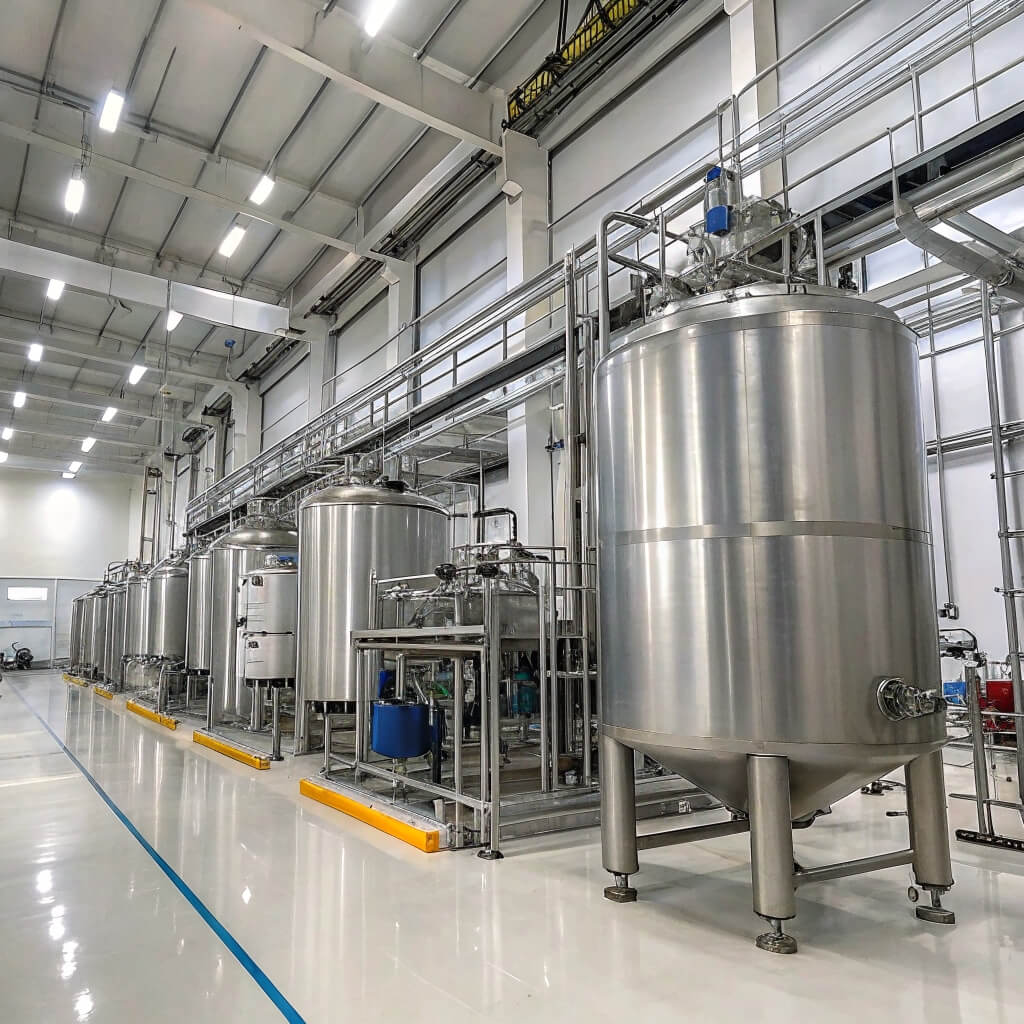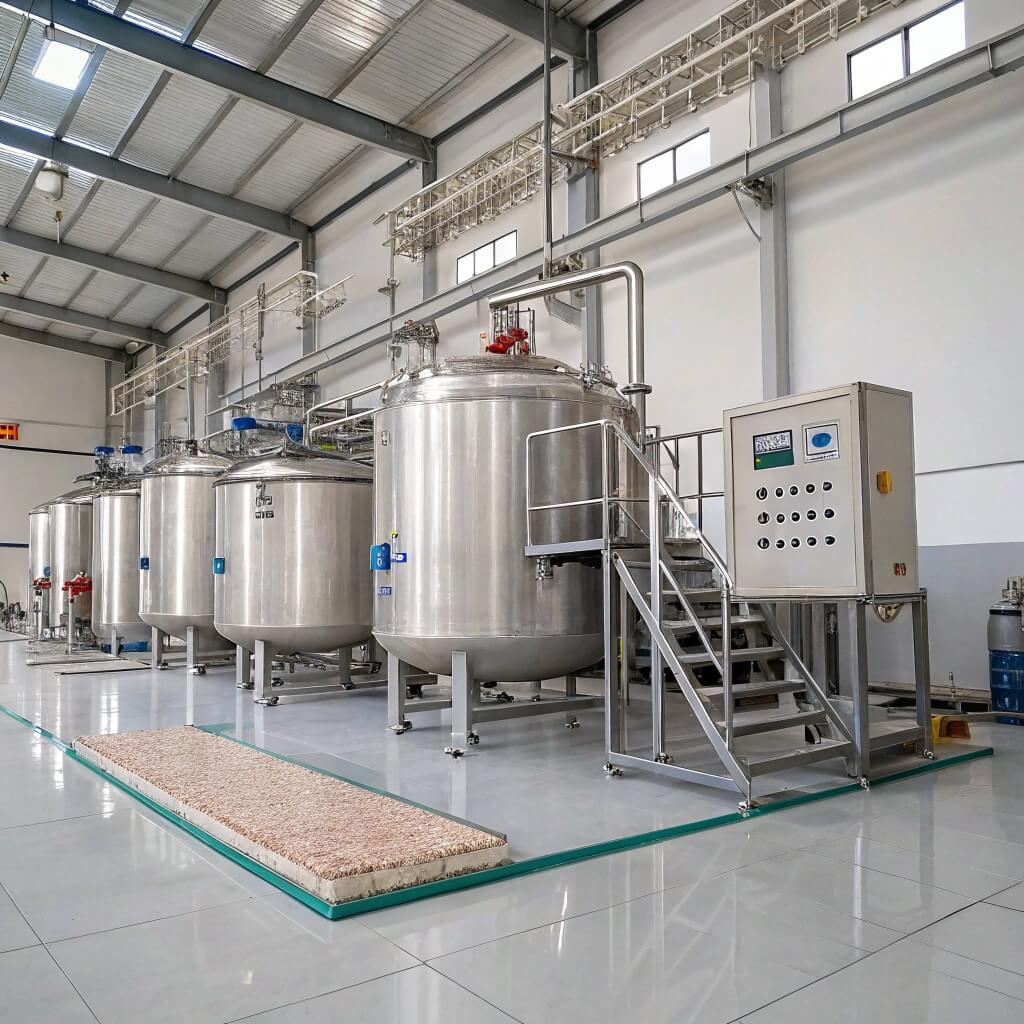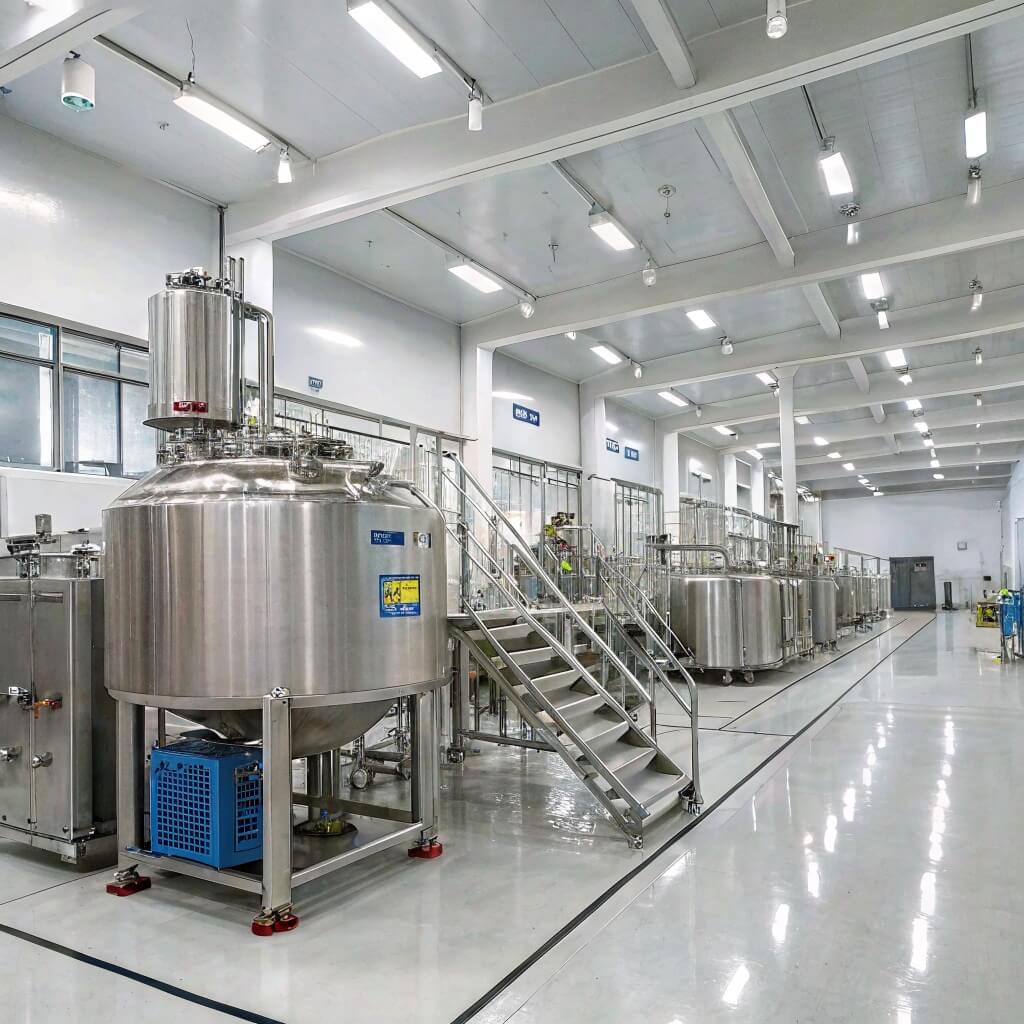Hydroxypropyl Methylcellulose (HPMC) is a versatile chemical compound used in a wide range of industries, from construction to pharmaceuticals and food production. It’s known for its ability to act as a thickening agent, stabilizer, and binder in various applications. This article will explore what HPMC is, its primary uses, and its importance in different industries. We will dive into its production process, examine its environmental impact, and look at the factors to consider when purchasing HPMC. Let’s uncover the key aspects of this valuable compound.

1. Qu'est-ce que l'HPMC ?
HPMC, or Hydroxypropyl Methylcellulose, is a cellulose derivative that has gained significant traction in industries that require controlled chemical properties, such as the pharmaceutical, food, and construction sectors. HPMC is a water-soluble polymer derived from natural cellulose sources. It’s made through a chemical process where methyl and hydroxypropyl groups are added to cellulose, making it more versatile and soluble in water. But here’s the kicker: this unique structure provides HPMC with a range of properties that make it ideal for different applications.
HPMC is colorless, odorless, and tasteless, which makes it suitable for use in food, pharmaceuticals, and cosmetics without altering the product’s flavor or appearance. Its solubility and thickening capabilities make it essential in the creation of products such as tile adhesives, pharmaceuticals, and even low-fat food products. In construction, HPMC helps improve the workability, water retention, and adhesion of various building materials. In pharmaceuticals, it is primarily used as a binder and controlled-release agent.
What’s the real story here? HPMC plays a critical role in enhancing the performance of products across many industries, acting as a stabilizer, thickener, and binder. For example, in the food industry, it can create a desirable texture in sauces and dressings. In construction, it ensures that mortar and adhesives perform as expected, even in harsh conditions. So, it’s more than just a simple additive; it’s a game-changer in product formulation and performance.
Table: Properties of HPMC
| Propriété | Description |
|---|---|
| Chemical Formula | C56H108O30 |
| Solubility in Water | Soluble in water |
| Apparence | Poudre blanche à blanc cassé |
| Common Uses | Pharmaceuticals, food, cosmetics, construction |
| Plage de viscosité | Variable, depending on the grade and formulation |
2. How is HPMC Made?
The manufacturing process of HPMC involves several steps, each crucial to achieving the desired product quality. First, cellulose, usually derived from plant sources such as wood or cotton, undergoes a chemical reaction with sodium hydroxide, which transforms the cellulose into a highly reactive compound. From there, methyl and hydroxypropyl groups are added through etherification. But here’s the kicker: it’s this modification that gives HPMC its unique properties like solubility, viscosity, and binding ability.
The process begins with refining the raw cellulose into a form that can undergo the etherification reaction. The cellulose is then treated with sodium hydroxide, which breaks down the structure of the cellulose fibers, allowing for the introduction of methyl and hydroxypropyl groups. This modification alters the cellulose’s solubility in water, making it easier to use in a wide range of applications.
Ready for the good part? The production process also involves neutralizing the product and drying it, which ensures that the HPMC is ready for use in various industrial applications. Different grades of HPMC can be produced by adjusting the levels of substitution (methyl and hydroxypropyl groups), leading to a wide variety of products that cater to specific needs in different industries.
Table: Production Process of HPMC
| Étape | Description |
|---|---|
| Matière première | Cellulose sourced from wood, cotton, or other plant fibers |
| Chemical Treatment | Cellulose reacts with sodium hydroxide |
| Ethérification | Methyl and hydroxypropyl groups are added |
| Neutralisation | The product is neutralized to ensure proper chemical balance |
| Séchage | The final product is dried to form a powder |
3. What are the Primary Uses of HPMC?
HPMC’s versatility makes it suitable for a broad range of applications across several industries. It’s used extensively in construction, where it improves the workability, adhesion, and water retention of mortar, plaster, and tile adhesives. In the pharmaceutical industry, it serves as a binder in tablets and a controlled-release agent in drug formulations. It is also used as an emulsifier and thickening agent in the food industry, where it helps to improve the texture and consistency of sauces, dressings, and beverages.
But here’s the kicker: HPMC’s uses extend beyond these industries into other areas, such as cosmetics and personal care. It can be found in shampoos, lotions, and facial cleansers, where it acts as a stabilizer, thickener, and emulsifier. The food industry benefits from its ability to improve texture and prevent ingredients from separating in products like salad dressings and low-fat foods.
This is where it gets interesting: HPMC is also used in the production of personal care products such as hair gels and skin lotions. It helps maintain the desired texture and consistency while also providing the benefits of moisture retention. By improving the feel of these products, HPMC plays a critical role in consumer satisfaction.
Table: Common Applications of HPMC
| Industrie | Application | Fonction |
|---|---|---|
| Construction | Mortars, tile adhesives | Improves workability, adhesion, water retention |
| Médicaments | Tablets, controlled-release formulations | Acts as a binder, enhances drug release |
| Nourriture | Sauces, dressings, beverages | Thickener, emulsifier, stabilizer |
| Produits de beauté | Shampoos, lotions, facial cleansers | Thickener, emulsifier, stabilizer |
4. Why is HPMC Important in the Construction Industry?
In construction, HPMC plays a pivotal role in enhancing the quality and performance of materials like tile adhesives, mortars, and plasters. Its ability to improve workability, water retention, and adhesion makes it indispensable in the production of construction products that need to perform under a variety of conditions. But here’s the kicker: without HPMC, these products might not have the consistency or durability needed to withstand real-world conditions.
HPMC is often included in dry mix mortars and adhesives, where it improves the handling characteristics of these products. In tile adhesives, it enhances the adhesion of tiles to the substrate, ensuring that the tiles remain in place even under stress. In mortars, it helps retain moisture, preventing the mixture from drying too quickly and ensuring that the surface remains workable for longer.
Ready for the good part? HPMC also reduces the risk of cracking and enhances the durability of the final product. For example, in plaster, it helps improve flexibility and reduces the chances of shrinkage cracks. This makes HPMC essential for products used in both interior and exterior applications.
Table: Role of HPMC in Construction
| Application | Fonction | Avantages |
|---|---|---|
| Adhésifs pour carrelage | Enhances adhesion to surfaces | Prevents tiles from slipping, improves durability |
| Mortars | Improves water retention and workability | Extends working time, reduces cracking risks |
| Plasters | Enhances flexibility and reduces shrinkage | Improves surface finish, enhances durability |
5. How Does HPMC Function as a Pharmaceutical Excipient?
In pharmaceuticals, HPMC is used primarily as a binder in tablets and a controlled-release agent in various drug formulations. Its ability to form a gel when mixed with water makes it ideal for use in controlled-release systems, ensuring that drugs are released at a steady rate over time. But here’s the kicker: HPMC’s ability to form a gel matrix is a key reason why it’s so valuable in pharmaceutical formulations.
When used in tablet production, HPMC helps bind the active ingredients together, ensuring that the tablet remains intact during manufacturing, storage, and ingestion. It also helps regulate the release of the drug in the body, ensuring that it’s released in a controlled manner. Ready for the good part? HPMC can be adjusted to control the release rate, allowing for better therapeutic outcomes, especially in drugs that need to be released over an extended period.
In addition, HPMC can be used as a thickening agent in liquid formulations, improving the viscosity and stability of the product. This makes it useful in the creation of suspensions, syrups, and other liquid medications.
Table: Pharmaceutical Uses of HPMC
| Application | Fonction | Avantages |
|---|---|---|
| Tablet Binders | Binds ingredients together, prevents disintegration | Ensures tablet integrity, improves shelf life |
| libération contrôlée | Forms a gel matrix to control drug release | Regulates drug delivery, improves therapeutic outcomes |
| Liquid Formulations | Thickening agent for suspensions and syrups | Enhances viscosity, stability |
6. What Are the Benefits of HPMC in Food and Cosmetics?
In the food and cosmetics industries, HPMC serves multiple roles, from thickening and stabilizing to emulsifying. In food products, it helps improve texture, prevent separation, and enhance the mouthfeel of low-fat or reduced-calorie items. Ready for the good part? It also acts as a fat replacer, offering the same creamy texture and consistency as traditional fats without the added calories.
In cosmetics, HPMC helps stabilize emulsions, ensuring that oil and water components do not separate. It also thickens creams and lotions, making them easier to apply. But here’s the kicker: its moisture-retaining properties make it ideal for use in moisturizing creams and shampoos, providing long-lasting hydration to the skin and hair.
What’s the real story? HPMC is a key ingredient in both food and cosmetic formulations, where it adds value by enhancing product texture and stability. Whether it’s in a sauce, shampoo, or facial cream, HPMC helps make these products more effective and appealing to consumers.
Table: HPMC in Food and Cosmetics
| Industrie | Application | Fonction |
|---|---|---|
| Nourriture | Low-fat foods, sauces | Thickener, emulsifier, stabilizer |
| Produits de beauté | Creams, lotions, shampoos | Thickener, stabilizer, moisture retention |
7. How Does HPMC Affect the Environment?
HPMC is a biodegradable compound, meaning that it will break down naturally over time, reducing its impact on the environment. However, the production process of HPMC does require energy and chemicals, which can have an environmental impact if not managed properly. Ready for the good part? HPMC can be produced sustainably with environmentally friendly practices, making it a viable option for eco-conscious companies.
What’s the real story? The environmental impact of HPMC is mainly tied to the production process, but efforts are being made to reduce this footprint by improving manufacturing techniques and sourcing renewable raw materials. As industries increasingly prioritize sustainability, HPMC’s biodegradability and versatility make it a valuable option for companies looking to meet eco-friendly standards.
Table: Environmental Impact of HPMC
| Facteur | Description |
|---|---|
| Biodégradabilité | HPMC is biodegradable and breaks down naturally |
| Production Impact | Manufacturing can use energy and chemicals |
| Sustainability Efforts | Renewable materials and eco-friendly practices reduce impact |
8. What Are the Key Factors to Consider When Purchasing HPMC?
When buying HPMC, it’s important to consider the grade, viscosity, and intended application. Different grades of HPMC are produced with varying levels of methyl and hydroxypropyl substitution, which affects their solubility, viscosity, and performance. Ready for the good part? By selecting the right grade of HPMC, companies can optimize the performance of their products, whether it’s for use in construction, pharmaceuticals, food, or cosmetics.
What’s the real story? Choosing the right supplier and ensuring the HPMC is manufactured to high standards is also crucial. Companies should verify that their supplier follows best practices in quality control and can provide the necessary certifications, such as ISO or GMP. By keeping these factors in mind, businesses can ensure that they’re getting the highest-quality HPMC for their applications.
Table: Key Considerations When Purchasing HPMC
| Facteur | Description |
|---|---|
| Grade | Different grades affect solubility and viscosity |
| Supplier Quality | Ensure suppliers meet certifications and quality standards |
| Intended Use | Match the grade of HPMC with the specific application |
9. What Are the Challenges in the HPMC Market?
The HPMC market faces several challenges, including supply chain disruptions, price volatility, and regulatory hurdles. Ready for the good part? Companies in the HPMC industry must continuously adapt to changing market conditions, such as fluctuations in raw material prices and shifts in consumer demand for eco-friendly products.
What’s the real story? Regulatory challenges, particularly in the food and pharmaceutical industries, can make it difficult for companies to navigate the market. Businesses must ensure that their HPMC products comply with the strict regulations governing these sectors. However, with proper planning and investment in innovation, companies can overcome these challenges and continue to thrive in the market.
Table: Challenges in the HPMC Market
| Défi | Description |
|---|---|
| Supply Chain Issues | Disruptions can affect availability and cost |
| Price Volatility | Fluctuations in raw material prices impact costs |
| Conformité réglementaire | Strict regulations in food and pharmaceuticals |
10. How to Properly Store and Handle HPMC for Optimal Performance?
To maintain the quality and effectiveness of HPMC, it must be stored in a cool, dry environment, away from direct sunlight and moisture. Ready for the good part? Proper handling involves using clean equipment and avoiding contamination to ensure that the HPMC remains pure and effective.
What’s the real story? If stored correctly, HPMC can have a long shelf life, making it an ideal choice for manufacturers who need to keep a steady supply of materials. Proper storage and handling not only preserve the quality of HPMC but also help maintain the consistency and performance of the final product.
Table: Storage and Handling of HPMC
| Facteur | Description |
|---|---|
| Storage Conditions | Store in cool, dry, and dark locations |
| Handling Precautions | Use clean equipment to avoid contamination |
| Shelf Life | Long shelf life if stored properly |
FAQ
Q1: Qu'est-ce que l'HPMC ?
HPMC (Hydroxypropyl Methylcellulose) is a versatile compound used in various industries, including construction, pharmaceuticals, and food. It acts as a thickener, stabilizer, and binder.
Q2: How does HPMC work in construction materials?
In construction, HPMC enhances the adhesion, workability, and water retention of materials such as tile adhesives and mortars.
Q3: Can HPMC be used in food and beverages?
Yes, HPMC is commonly used in the food industry as a thickener and emulsifier to improve texture and consistency in products like sauces and dressings.
Q4: How does HPMC impact the pharmaceutical industry?
In pharmaceuticals, HPMC is used as a binder and controlled-release agent in tablets and other formulations, enhancing drug stability and release.
Q5: What factors should be considered when choosing the right HPMC grade?
The right grade depends on the specific application, such as viscosity and solubility, and should match the product’s intended use. Ensure the supplier meets quality standards.




